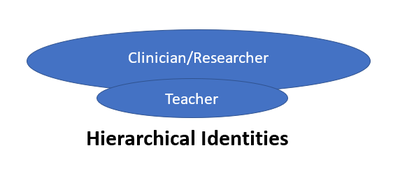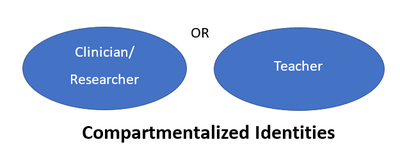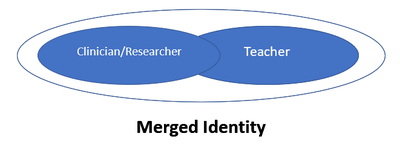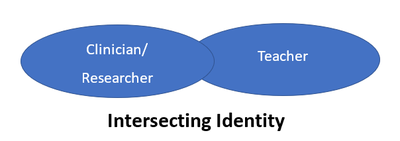Have you ever doubted who you are professionally? If you are like most faculty in a health center, then, probably not. As Faculty on the HSC campus, we are identified as physicians, nurses, dentists, researchers or public health officials. Our professional identity answers the question, “Just what do you do?”. In addition, that identity is:
How we understand ourselves
How we interpret experiences
How we present ourselves
How we are perceived and recognized by the community outside of work
We don’t doubt our professional identity as clinicians and researchers because we have spent a decade or more training for the professional roles that we occupy. Along the way, we have acquired our mantle of identity as we learn from mentors, and as we engage in our healthcare environment over years of work in our field.
But what about our professional identity as educators? All of us have some role in education teaching students in medicine, dentistry, nursing and public health. We may be teaching residents, graduate students or post-graduate fellows. Yet, we aren’t likely to introduce ourselves as educators. Only now, after 34 years at the School of Medicine and a dramatic transition into faculty development two years ago, do I primarily introduce myself as a Faculty Development VP for the HSC schools, and then as a pediatric infectious disease physician. So why is that? I think it is because we have been far less deliberate in developing our professional identity as educators. Perhaps we feel like we have not invested sufficiently in keeping up with the neuroscience of learning, or the high-impact teaching strategies that make learning stick. Whatever the reason, it is important that we understand the relationship between our role as professional clinician or researcher and our role as educator because we cannot ignore our educator identity. The essential question is, “To what extent is being a teacher an important part of your professional identity?”
We need to invest in our professional identity as educators and nurture its development because for most of us it likely is lagging or subservient to our clinician or researcher roles. The educator identity is a source of meaning and an organizing element in the teaching aspects of our work as faculty and has the great potential to magnify our impact as we train the next generation of healthcare providers and scientists. But does this educator identity compete with our identity as clinician or researcher? How are these identities balanced? A 2020 publication (Supporting a teacher identity in health professions education: AMEE Guide No. 132, Medical Teacher, 43:2,124-136) speaks to the importance of a professional educator identity and provides models for how clinician/researchers juggle their educator identities. The authors describe four models of this relationship:  Hierarchical Identities: Teaching is seen as secondary to the principal identity as clinician or researcher
Hierarchical Identities: Teaching is seen as secondary to the principal identity as clinician or researcher  Compartmentalized Identity: We adopt different identities depending on the context of our work environment; it is an either/or identity
Compartmentalized Identity: We adopt different identities depending on the context of our work environment; it is an either/or identity Merged Identity: Our different roles are connected and important to us in all contexts of our work
Merged Identity: Our different roles are connected and important to us in all contexts of our work Intersecting Identity: We stress the unique combination of both identities to make the work interesting
Intersecting Identity: We stress the unique combination of both identities to make the work interesting
These models are not necessarily static and will likely evolve over the course of your career. In my case, I have transitioned from a hierarchical identity, then to an intersecting and then finally to a merged identity, over the course of my career at UofL. As such, we should consider educator identity formation as a journey, and we can prepare for that journey with the goal of ensuring that our learners learn. The real question is not, “how did we (the teacher) do?”, but rather, “did the learners learn anything from us?” The referenced article (AMEE Guide) provides four suggestions for us to be more deliberate in our professional educator identity formation:
Practice your teaching skills with learning science in mind and seek feedback about your teaching effectiveness from someone who knows what effective teaching looks like.
Build a network of educators (at UofL and beyond) including a peer mentor and a senior educator mentor. Attend meetings focused on education and develop/join a community of educators.
Reflect on your educator identity…write your philosophy of teaching, think about your teaching goals, consider your career path and destination as a health sciences educator.
In the end, for us to contribute to UofL’s commitment to make this university a great place to learn, we should consider the question,
“To what extent is being a teacher an important part of my professional identity?”
References:
van Lankveld, T., Thampy, H., Cantillon, P., Horsburgh, J., & Kluijtmans, M. (2021). Supporting a teacher identity in health professions education: AMEE Guide No. 132. Medical teacher, 43(2), 124–136. https://doi.org/10.1080/0142159X.2020.1838463
 Hierarchical Identities: Teaching is seen as secondary to the principal identity as clinician or researcher
Hierarchical Identities: Teaching is seen as secondary to the principal identity as clinician or researcher  Compartmentalized Identity: We adopt different identities depending on the context of our work environment; it is an either/or identity
Compartmentalized Identity: We adopt different identities depending on the context of our work environment; it is an either/or identity Merged Identity: Our different roles are connected and important to us in all contexts of our work
Merged Identity: Our different roles are connected and important to us in all contexts of our work Intersecting Identity: We stress the unique combination of both identities to make the work interesting
Intersecting Identity: We stress the unique combination of both identities to make the work interesting